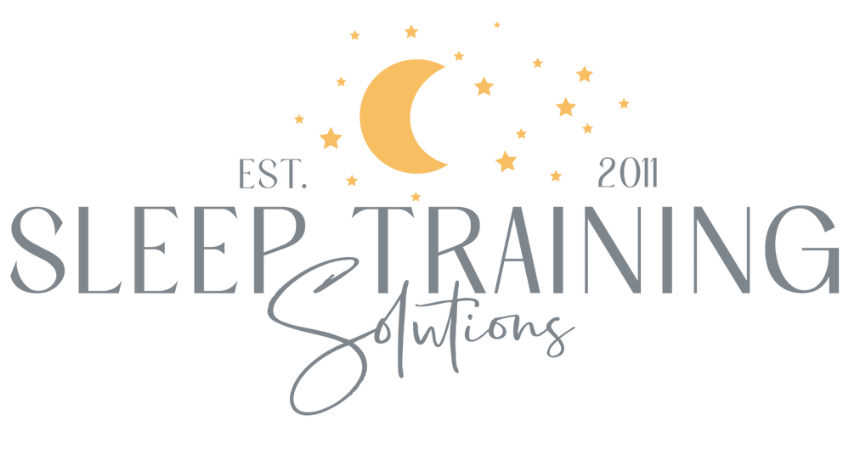Tips to make sleep training easier
How can you make sleep training easier?
Every tired parent is looking for that secret step that makes sleep training easier. After being a sleep consultant for the past 12 years, I’m here to tell you there isn’t a “secret sauce” when it comes to sleep training BUT there are definitely things you, as the parent, can do to make the process easier, for you and your little one!
When to start sleep training
Timing, they say, is everything - and it’s certainly true with sleep training!
After working with families of all ages and seeing which ages bring the fastest results, I personally believe that sleep training is easiest between 4-6 months of age.
There’s a couple reasons for this:
babies this age are starting to have bigger, less frequent feeds which allows them to sleep longer stretches at night
sleep prop dependence is starting, but not yet a solid habit
separation anxiety hasn’t come into play yet
You can absolutely sleep train when your baby is 9 months, 12 months or older, but many parents find that the process will be a little more challenging because that sleep prop dependence and separation anxiety have both become stronger.
The other timing piece to consider to make sleep training easier is choosing an appropriate time when you can fully commit to the process. Starting the weekend before you go back to work from maternity leave or are leaving for vacation doesn’t leave enough time for your baby to learn these new skills before introducing a brand new environment or big change (like a nanny or daycare).
You’ll also want to consider your work schedule. Choose a time between big projects if you can so if you’re a little more tired those first few nights of sleep training, your job won’t suffer.
How to make sleep training easier
Get your mindset in the right place
How many people have warned you against sleep training? Or told you that you should have started months ago?
There will always be people who share their opinions, even when their opinion is not requested (or wanted). YOU alone know if sleep training is the right next step for your family. And if you make the choice that it is, you need to tune out all the other noise because it isn’t helpful to you…and take steps to move forward.
That might be getting a sleep training book, taking an online baby sleep course (use this link for 50% off!) or working 1-to-1 with a consultant so that you have a plan and aren’t just throwing spaghetti at the wall, waiting for something to stick!
Once you have the confidence that this is right for your family and you’re excited about the plan you’ll follow, the process really gets so much easier because you’ve taken away the “what ifs”.Give yourself grace and realize it’s a process, but you need a plan
I can’t tell you how many families I’ve talked to on an evaluation call that tell me they are stuck in the never-ending cycle - they try sleep training, but baby cries so they cave and give back the old sleep props, and then try again a couple weeks later because they’re not in a better place sleep-wise, and even more exhausted than before…and the cycle starts again!
It makes me sad to hear these stories because had I been there supporting them the first time, I would have been able to tell them a) this isn’t the right method, or b) you’re experiencing the extinction burst where it gets worse right before it gets better! This is why I’m such a big proponent of not doing sleep training alone. Knowing you’re on the right path and when things will start improving makes the whole process feel easier.
Remember that the single most important piece to this process is being consistent with your plan. I guarantee that sleep training will be SO much easier (and take less time) if you take away the pacifier (or whatever sleep prop your baby was using to get drowsy or fall asleep) and don’t flip-flop back and forth. Don’t remove it one night and then cave and offer it the next night. This is so confusing for your child! Make it easy for him or her to learn the new “sleep rules” you’re teaching by being consistent in your approach. If you need help developing a plan for your little one, let me help.Take care of any medical issues
Obviously if your child is uncomfortable due to reflux or eczema, it makes being able to fall asleep so much harder. But also look at the side effects of any medication your child is taking…
I had horrific asthma as a child - nebulizers, inhalers, trips to the ER - and when you’re having trouble breathing, there’s no chance of being able to fall asleep. But one thing many parents of asthmatics don’t realize is that the inhalers often make a child wired and hyper.
If your child has a chronic condition that requires medication, look at the side effects and see whether restlessness or sleeplessness is one of them. Whether it’s asthma or reflux, many meds will make it harder for your little one to fall asleep, so adjusting the timing you give the medication (if possible) or switching to a different one can help. For any medication questions, always consult your doctor.
You can also research whether there may be a more natural route to take. As an adult, I made a log to see when my asthma flaired up and realized it was usually associated with the day we did the weekly house cleaning, so it was related to the chemicals being used. Switching those to non-toxic made a huge difference, as well as adjusting my diet because my research showed that fungus in the lungs was also an issue. (For anyone specifically struggling with asthma, I’m happy to connect privately and share my personal experience.)
For reflux, many breastfeeding mothers are able to adjust their diets to avoid certain foods that exacerbate reflux symptoms. Typically vegetables (not sweet potato), fruits, meat and eggs are are more easily digested in breastmilk by babies with reflux.
For eczema, there are more natural soaps and lotions that have helped my clients’ babies get off prednizone creams and be able to take the daily baths their babies loved so much.
So bottom line…figure out if a medical issue (or the side effects of the medication) are affecting sleep and try to resolve those issues or make adjustments before you start sleep training. Remember to always consult with your doctor about any questions you have about your child’s medication or medical issue.Find the right window
It’s important to learn what your child’s schedule should be for his or her age prior to sleep training so that your baby isn’t going into bedtime overtired.
Overtiredness makes it harder to fall asleep (and stay asleep) so you want to avoid it! If you miss that window of opportunity for bedtime, your little one will get his or her second wind and you’ll need to wait for that to pass before trying again. At that point, bedtime will be so much later that it will affect nightwakings and early wakings.
Remember that for 4 and 5 month olds, you’ll have a schedule based on awake time and 6 months and older, you’ll have a set two nap schedule:
4 month olds - awake time 1.5-1.75 hours - 4 naps/each day equaling 4 hours of day sleep
5 month olds - awake time 2-2.5 hours - 3 naps/each day equaling 3.5 hours of day sleep
6 month olds - 2 naps/each day equaling ~3 hours of day sleep
These tips aren’t the “magic formula” formula that makes sleep training a completely cry-free experience (wouldn’t THAT be nice if it existed!), but timing, mindset, having a proper plan, being consistent, taking care of medical conditions prior and making sure your little one isn’t overtired will make sleep training so much easier!
If you are ready to start but not sure how to develop a plan or need guidance to follow through, that’s what I’m here for.
There are so many pieces to successfully sleep training - Download your free PDF to help set you up for success!
What can I do to make sleep training more effective?
Related Posts:
This post is for informational purposes only and may not be the best fit for you, your child and/or your personal situation. It shall not be construed as medical advice. The information and education provided here is not intended or implied to supplement or replace professional medical treatment, advice, and/or diagnosis. Always check with your child’s physician or medical professional before trying or implementing any information read here.
Please note that some of this site’s links are affiliate links, and Sleep Training Solutions is a participant in the Amazon Services LLC Associates Program, an affiliate advertising program designed to provide a means for sites to earn advertising fees by advertising and linking to Amazon.com and affiliated websites. I will earn a small commission, at no additional cost to you, if you purchase them.







